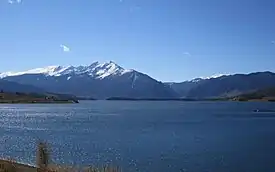
Denver Water is a water utility that operates as a public agency servering the City and County of Denver, Colorado, and a portion of its surrounding suburbs. Established in 1918, the utility is funded by water rates and new tap fees rather than taxes. It is Colorado's oldest and largest water utility.[1]
Overview
Denver Water's primary water sources are the South Platte River, Blue River, Williams Fork, and Fraser River watersheds, but it also uses water from the South Boulder Creek, Ralston Creek, and Bear Creek watersheds.[2]
History
The first residents of the Denver area drank water directly from nearby creeks and rivers. Surface wells and buckets of water sufficed for a while as a delivery system, but they soon proved inadequate.[3] Between 1859 and 1918 at least twelve different private water companies were formed in the Denver area.[4]
In 1870, the community was growing at a rapid rate. To keep up with demand from the area's 5,000 residents, the Denver City Water Company was formed. In 1872, with a large well, a steam pump and four miles (six kilometers) of mains, Denver City Water Company began to provide water to homes. Over the next two decades, 10 water companies fought, collapsed, or merged. Several companies merged, and in 1894, the Denver Union Water Company—predecessor of Denver Water—emerged to establish a stable system.
In 1918, Denver residents voted to form a five-member Board of Water Commissioners and buy the Denver Union Water Company's water system for $14 million, creating Denver Water. From that time on, Denver Water planned and developed a system to meet the needs of the people of Denver and the surrounding areas.[3][5]
Flash floods between 1996 and 2002 led to erosion and damage to Denver's reservoirs. This erosion was exacerbated by insects and disease in the 1990s that had weakened forests. To address this, Denver Water began replanting mountainsides with drought-resistant trees in order to better maintain its waterways.[6]
Lead service pipes
Lead pipes were used to hook homes to water mains until the World War II era. Although lead pipes were banned in 1971, Denver Water officials estimate that there are between 64,000 and 84,000 homes still being serviced with lead pipes. A $500 million program to replace them is proceeding as of 2021 at the rate of about 5,000 homes a year. Whether a particular address has a lead service line may be searched for on a page on the Denver Water website.[7]
See also
References
- ↑ "About Us". Denver Water. Retrieved August 1, 2017.
- ↑ "Collection System". Denver Water. Retrieved August 1, 2017.
- 1 2 "History". Denver Water. Retrieved August 1, 2017.
- ↑ Limerick, Patricia Nelson; Hanson, Jason L. (2012). A Ditch in Time : the City, the West, and Water (1st ed.). Golden, Colorado: Fulcrum Publishing. pp. 28–29. ISBN 978-1-55591-366-3. Retrieved November 9, 2023.
- ↑ "From high in the Rockies to the South Platte, here's where Denver gets its water". Denverite. Retrieved February 8, 2023.
- ↑ Velasquez-Manoff, Moises; Khosravani, Andrew (April 25, 2019). "Can Humans Help Trees Outrun Climate Change?". The New York Times. Retrieved March 26, 2020.
- ↑ Conrad Swanson (June 11, 2021). "Denver Water is replacing decades-old toxic lead pipes faster than expected The $500 million program replacing lines for up to 84,000 homes, likely to take 15 years". The Denver Post. Retrieved June 11, 2021.
In late 2019. the U.S. Environmental Protection Agency approved Denver Water's replacement plan on a trial basis. The idea is to map out and replace all the lead service lines in town within 15 years and at an estimated cost of about $500 million.